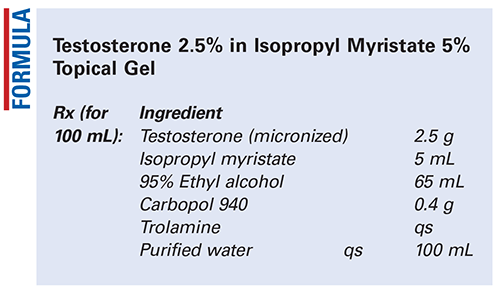US Pharm. 2019;44(8):48-49.

Method of Preparation: Calculate the required quantity of each ingredient for the total amount to be prepared. Accurately weigh and/or measure each ingredient. Dissolve the testosterone in the ethyl alcohol while mixing. Disperse the Carbopol 940 in the solution while mixing; this may take up to 30 minutes. Add the isopropyl myristate and mix well to form a thin gel. Bring the mixture to 90% of the total volume with purified water and mix well. Dropwise, add trolamine while mixing until the desired thickness of gel is achieved. Bring the mixture to final volume with purified water and mix well. Package and label.
Use: Testosterone topical gels have been used in the treatment of low testosterone concentrations in men and low libido in women.1
Packaging: Package in tight, light-resistant containers.
Labeling: Keep out of reach of children. Store in a cool place. Use only as directed. For external use. Discard after ____ [time period].
Stability: A beyond-use date of 30 days may be used for this preparation.1
Quality Control: Quality-control assessment can include theoretical weight compared with actual weight, pH, specific gravity, active drug assay, color, texture–surface, texture–spatula spread, appearance, feel, rheologic properties, and physical observations.2
Discussion: Testosterone (Androderm, Androgel, C19H28O2, MW 288.42) occurs as white or slightly cream-colored crystals or crystalline powder that is odorless and stable in air. Testosterone is practically insoluble in water; it is soluble 1 g in 5 mL of ethanol, 2 mL of chloroform, and 100 mL of ether, and it is soluble in vegetable oils. Testosterone is not very bioavailable when given as an oral-swallow preparation, but it is absorbed when it is administered buccally and sublingually. Testosterone is indicated as androgen replacement for delayed male puberty, postpartum breast pain and engorgement, inoperable breast cancer, and male hypogonadism.3
Isopropyl myristate (C17H34O2, MW 270.51) is composed of esters of propan-2-ol and saturated high-molecular-weight fatty acids, principally myristic acid. It is used as an emollient, solvent, skin penetrant, and oleaginous vehicle. Isopropyl myristate is a clear, colorless, practically odorless, mobile liquid with a bland taste, and it has a specific gravity of 0.846 to 0.854. Isopropyl myristate is miscible with ethanol, ethyl acetate, fats, fatty alcohols, fixed oils, and waxes, and it is practically insoluble in water.4
95% Alcohol (ethyl alcohol, ethanol, grain alcohol, C2H5OH, MW 46.07) is a clear, colorless, mobile, and volatile liquid with a slight characteristic odor and a burning taste. Its specific gravity is between 0.812 and 0.816, and its boiling point is 78.15°C. 95% Alcohol is miscible with glycerin and water.5
Carbopol 940 is a synthetic high-molecular-weight polymer. It occurs as white-colored, fluffy, acidic, hygroscopic powders with a slight characteristic odor; in this preparation, it is used as a gelling agent. Carbopol 940 is soluble in water and, after neutralization, in 95% ethanol and in glycerin. Maximum viscosity can generally be obtained in a pH range of 6 to 11.6
Trolamine (TEA, triethanolamine) is an alkalizing and emulsifying agent. It occurs as a variable mixture of alkanolamines, and it is a clear, colorless to pale yellow, viscous liquid with a slight ammoniacal odor. Its specific gravity is approximately 1.120 to 1.128 g/mL, and it has a pH of 10.5 in a 0.1N aqueous solution. Trolamine is highly hygroscopic and is miscible with water and 95% ethanol.7
REFERENCES
1. U.S. Pharmacopeia/National Formulary [current revision]. Rockville, MD: U.S. Pharmacopeial Convention, Inc; July 2019.
2. Allen LV Jr. Standard operating procedure for performing physical quality assessment of ointments/creams/gels. IJPC. 1998;2:308-309.
3. Testosterone. In: Lund W, ed. The Pharmaceutical Codex. 12th ed. London, England: Pharmaceutical Press; 1994:1135-1136.
4. Quinn ME. Isopropyl myristate. In: Sheskey PJ, Cook WG, Cable CG, eds. Handbook of Pharmaceutical Excipients. 8th ed. London, England: Pharmaceutical Press; 2017:495-497.
5. Fenton ME. Ethanol. In: Sheskey PJ, Cook WG, Cable CG, eds. Handbook of Pharmaceutical Excipients. 8th ed. London, England: Pharmaceutical Press; 2017:356-359.
6. Draganoiu E, Rajabi-Siahboomi A, Tiwari S. Carbomer. In: Sheskey PJ, Cook WG, Cable CG, eds. Handbook of Pharmaceutical Excipients. 8th ed. London, England: Pharmaceutical Press; 2017:165-170.
7. Goskonda SR, Triethanolamine. In: Sheskey PJ, Cook WG, Cable CG, eds. Handbook of Pharmaceutical Excipients. 8th ed. London, England: Pharmaceutical Press; 2017:994-996.
To comment on this article, contact rdavidson@uspharmacist.com.





